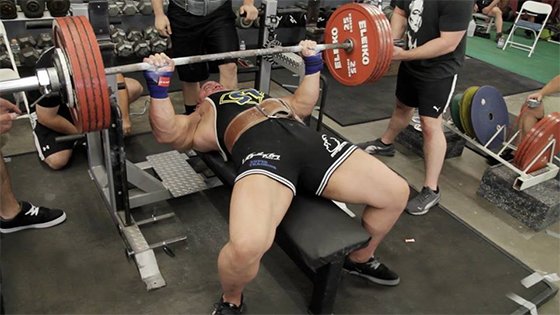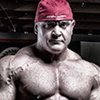I'm no powerlifter. Don't want to be one, either. But I do want to get stronger and be able to bench my bodyweight and then some. What advice can you give lifters like me?
A lot of the information circulating about the bench press is false. Or at least it's false in that it doesn't apply to everyone. Here's the problem: A lot of big, fat dudes gravitate toward powerlifting and strength sports. For better or worse, these guys give cues that apply to themselves, and not to everybody else.
When I hear cues like "tuck the elbows" or "press in a straight line" I get pretty aggravated. The jacked and tan dude, the skinny guy, and the non-powerlifter girl aren't going to have a super-short range of motion, and they're probably not going to bench like a rotund powerlifter. When you have a huge belly, your bench press technique is going to look different than that of most people. So why would everyone else want to bench like you?
If you want technique that can work for the masses, I've got it. Here are six steps so developing a better, heavier bench press. Trust me: You can put a lot more weight on the bar just by using proper form.
Mark Bell Coaches the Bench Press
Watch The Video - 14:30
Step 1 Grab the barbell evenly
This seems simple, but often when people get under the bar and wiggle, they grab the bar with a slightly uneven grip. They may not even realize they're doing it, but it's easy to fix. Use the power rings or the smooth part of the bar to measure where your grip should be. Grab the bar about a thumb's length out from the edge of the smooth part of the bar. That will give you a strong, balanced grip. It'll also be a close grip, but so what—work your triceps.
If you want to try a standard grip, place your pinky or ring finger directly on the power ring. To get the most weight up, powerlifters usually set their grip as wide as possible, which shortens the range of motion. This can be helpful but isn't critical. Nothing matters more in lifting weights than being in a good position and remaining in that good position throughout the entire lift.
Step 2 Squeeze the bar hard
Once you have a hold on the bar, squeeze the damn thing. Flex the forearm to activate your entire arm. If you were to shake somebody's hand as hard as you could, you'd notice that you tense all the way from your hand to your biceps, into the shoulder, and even include your neck. All that strength will disperse to the muscles that need to work.
Squeezing the bar can also alleviate elbow tendonitis. It won't cure it, but it will help. I know it sounds weird, but trust me on this.

Step 3 Position your feet
I like to lock down the lower body before I adjust my upper body. This is important because you have to keep your lower body and feet planted while you move your upper body into the correct position.
Try to make sure your feet aren't pointed too far outward. It's OK if they're out a little, but not so much that we lose all hip tension. We want torque. Normally, feet go underneath your knees and toes underneath the knee cap. Drive your stomach upward and flex and drive your heel toward the ground. Your hips will be higher than your knee, which creates stabilization. This is a strong, repeatable bench press stance.
Step 4 Set your upper body
To put their body in the right position, a lot of guys grab the bar with an underhand grip and curl their body up toward the bar. If you want to do this, go for it, but remember to keep the shoulder blades down and back. To simplify the whole process, just pull your chest toward the bar and keep it there.
Step 5 Lower the weight with your elbows in
Hopefully, you have somebody to lift off for you. You don't want to unwind yourself and screw up before you even start. Learn to bring weights out and over the largest part of your upper body, which should be about where your sternum is.

From here, slightly bring the elbows inward. If you don't bring elbows in, you can't bring them out very well. Keep the chest up and try to get your wrist, elbow, and barbell in alignment, or at least close to it. Bring the bar slightly below your nipples and touch on the sternum. Some people like being higher—that's fine, but make sure you're not flaring your elbows out. If your elbows are too far out, you'll get stuck.
A good cue is to keep your chest hidden beneath the bar. You don't want to go full-frontal. Your forearm should touch your biceps and your triceps should touch your lats.
Step 6 Press by driving elbows out and up
At the bottom of the lift your elbows are in. Now you have to bring them out again. Press the barbell by driving the elbows out and up, but don't let them get too far away from your body. At the end of the press, the weight should be locked out above your chin or nose. The travel pattern of the bar will be in a slight arc.


